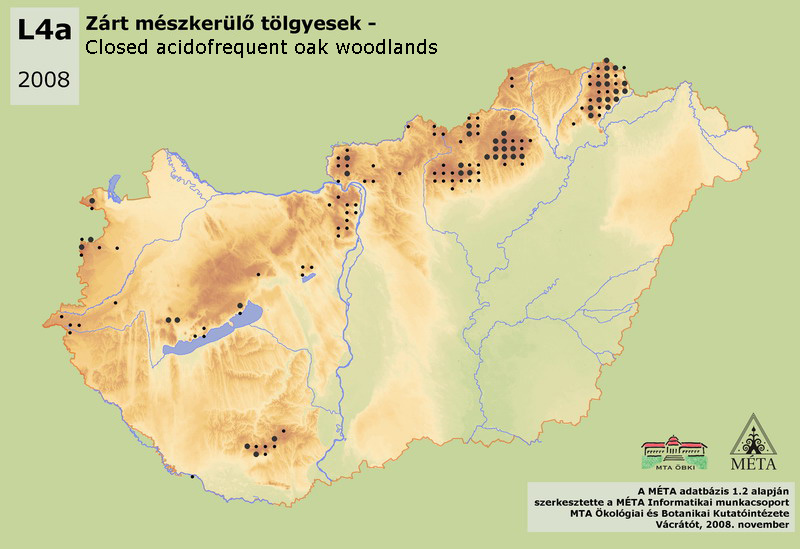MÉTA Program >>> Élőhelyek elterjedési térképei


L4a - Zárt mészkerülő tölgyesek:
Tölgyes és bükkös régióban, szélsőségesen savanyú talajokon kialakult, rendszerint gyenge-közepes növekedésű, záródó, cserjeszint nélküli erdők, ahol a lombkoronaszint domináns faja a kocsánytalan tölgy (Quercus petraea), a gyepszintet mészkerülő lomberdei fajok [pl. fehér perjeszittyó - Luzula luzuloides, erdei sédbúza - Deschampsia (Avenella) flexuosa, fekete áfonya - Vaccinium myrtillus, stb.] jellemzik. A mohaszint borítása jelentős lehet. Teljes hazai kiterjedése mintegy 2300 ha, ennek nagyobb része (1700 ha) az Északi-középhegység magasabb részein található (Zempléni-hegység, Bükk, Márta, Hevesi-Borsodi-dombság, Börzsöny). A Dunántúli-középhegységben csak szigetszerűen találni (300 ha, elsősorban Visegrádi-hegység, Budai-hegység, Velencei-hegység, Balaton-felvidék). Előfordul még a Nyugat-Dunántúl nyugati peremén (100 ha, Soproni-hegység, Kőszegi-hegység, Őrség-Vendvidék) és a Dél-Dunántúlon, a Mecsekben (200 ha). Hegyvidéki jellegű, savanyú alapkőzethez (andezit, riolit, gránit, savanyú homokkövek, palák) és száraz, sekély talajhoz kapcsolódó, jól felismerhető élőhely, a cseres-tölgyesekhez [L2a, L2b] csatlakozhat nehezebben felismerhető átmenetekkel.
L4a – Closed acidofrequent oak woodlands:
Low or medium high growing, closed forests in the oak and beech zone, developed on extremely acid soils. Submontane habitat type, connected to acid bedrock (andesite, rhyolite, granite, acid sandstones, shales) and to shallow, dry soils, occurring mainly on south slopes. The dominant tree species is Quercus petraea, the shrub layer is missing, the herb layer is characterised by acidofrequent forest species [Luzula luzuloides, Deschampsia (Avenella) flexuosa, Vaccinium myrtillus, etc.], the moss layer can be significant. The total area of the habitat is 2300 ha in Hungary. The greater part of the occurrences is in the higher regions of the Északi-középhegyég (Sátor-hegység, Bükk, Mátra, Heves-Borsodi-dombság, Börzsöny). There are some sporadic occurrences in the Dunántúli-középhegység (300 ha, especially in the Visegrádi-hegység, Budai-hegység, Velencei-hegység, and on Balaton-felvidék). It can be found at the western edge of Nyugat-Dunántúl (100 ha, Soproni-hegység, Kőszegi-hegység, Őrség-Vendvidék) and on Dél-Dunántúl, in Mecsek (200 ha). Though it is usually easy to recognize this habitat, there are barely identifiable transitional stands towards turkey oak woodlands (L2a, L2b).
Molnár, Zs., M. Biró, J. Bölöni & F. Horváth (2008): Distribution of the (semi-)natural habitats in Hungary I.: Marshes and grasslands, Acta Botanica Hungarica 50 (Suppl): 59-105. >>> letöltés (5,4 MB, PDF)
MÉTA Program,
MÉTA Fotótár
MÉTA Élőhely-Ismereti Útmutató (ÉIÚ),
MÉTA Adatlap-Kitöltési Útmutató (AL-KÚ)
(C) MÉTA Informatika, 2005-2009,
MTA Ökológiai és Botanikai Kutatóintézete